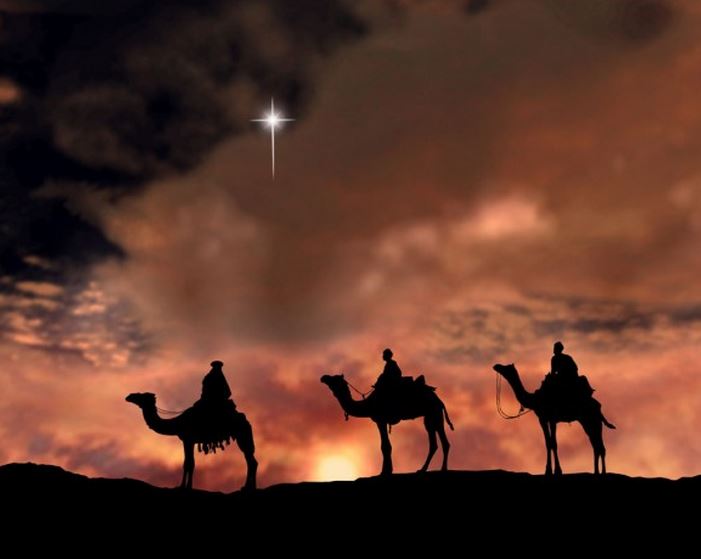 “O star of wonder, star of night,
“O star of wonder, star of night,
Star with royal beauty bright,
Westward leading, still proceeding,
Guide us to thy perfect light.”
It may be the most famous star in history. But was it real? Mentioned just once in the gospel of Matthew, the “Star of Bethlehem”, or the “Christmas Star”, may have guided three wise men from the East in search of a newborn king. A few words written on a scroll two thousand years ago isn’t much to go on, but astronomers have a few ideas that may explain the apparition of a star near the time of the birth of Jesus.
The words below from the gospel of Matthew were written by an unknown author in about 90 A.D. It’s not exactly a detailed observational report, at least by modern standards. There is no estimate of the star’s brightness, motion, color, duration, and so forth. But it’s all the astronomy we’ve got:
“Now, when Jesus was born in Bethlehem of Judea, in the days of Herod the king, behold, there came wise men from the east to Jerusalem, saying, Where is he that is born King of the Jews? For we have seen his star in the east, and are come to worship him.
And lo, the star, which they had seen in the east, went before them, till it came and stood over where the young child was. When they saw the star, they rejoiced with exceeding great joy.”
We also know that– religion aside– Jesus was an historical figure, a Jewish teacher who lived and travelled in and around Galilee until his death around 33-36 A.D. In 523 A.D., the Roman abbot Dionysius Exiguus placed the birth of Jesus at what we call 0 A.D., but he erred in determining the year in which Augustus Caesar began his rule, and he did not consider the year between 1 B.C. and 1 A.D. because “zero” was not regarded as a number in those days. Scholars now widely agree Jesus was born sometime between the years 7 B.C. and 2 B.C.
So there may have been a bright “star”, something unusual, between the years 7 B.C. and 2 B.C. These are the clues.

What astronomical event could explain the “Star of Bethlehem”?
Leaving aside divine occurrences, there are four explanations for a transient bright “star” around the time of the birth of Jesus:
A meteor. A bright meteor would capture the attention of wise men. But it would be too transient to guide them on a long journey to the Roman province of Judea. And it would not be visible from a wide area on Earth since meteors occur just 60-80 km above the Earth’s surface. This is the least likely explanation.
A comet. A bright comet might be interpreted as a star, and it could be widely visible over the Earth for many weeks. Comet Halley appeared a few years too early in 12 B.C. And comets were beheld by the ancients as bad omens, not something to announce the birth of a new king. Nor did Chinese and Korean stargazers, who kept records in those days, note an exceedingly bright comet.
A nova or supernova. A flaring or exploding star would fit the bill. There is some record made by Chinese astronomers of a nova in 5 B.C. in Aquarius or Capricornus, but it was not particularly bright or noteworthy.
A planetary conjunction. A conjunction, the apparent close approach of two bright planets, is perhaps the most promising explanation for the Star of Bethlehem. By running the celestial clockworks back in time, astronomers know a rare “triple alignment” of Jupiter and Saturn occurred in 7 B.C. when the planets approached each other closely three times between April and December. The first approach may have alerted the wise men, and by the time they traveled to Judea to pay respects, the planets would have approached each other again to appear nearly as a single “star”.
Even more striking conjunctions occurred in 3 B.C. and 2 B.C., this time between the two brightest planets Jupiter and Venus in the constellation Leo. The planets came as close as 12 arc-minutes of each other during these conjunctions, close enough to appear as a single very bright star. The first conjunction would have been visible in August of 3 B.C. in the eastern sky before dawn, which corresponds to the location described by the wise men in the gospel of Matthew. Jupiter and Leo were associated by the ancients with kings, and Venus was associated with fertility. So to three ancient Babylonian astrologers—the “wise men”—this event may have heralded the birth of a new king and got them packed and headed west. When they arrived in Judea months later, in June, Venus and Jupiter would have returned together for a second close approach in the western sky.
Does that means Jesus was born in June? That would help explain the words in the gospel of Luke, “And there were in the same country shepherds abiding in the field, keeping watch over their flock by night”. Shepherds in Judea would tend newborn lambs in the spring not in December. Many historians suspect the date of remembrance of the birth of Jesus was chosen by early Christians to coincide with the ancient Roman winter festival of Saturnalia, possibly as a way to disguise their celebration and avoid persecution in the centuries before their religion was sanctioned in the Roman Empire.
So does a Jupiter-Venus conjunction explain the Star of Bethlehem? Perhaps. Many astronomers and historians suggest the star is apocryphal, an element added to the gospel of Matthew decades after the birth of Jesus to add drama and mystery. Unless an archeologist uncovers more astronomical or historical records, it’s unlikely we’ll ever know for certain the identity of the Star.
But life can be more interesting with a little mystery, don’t you think?
Share This: